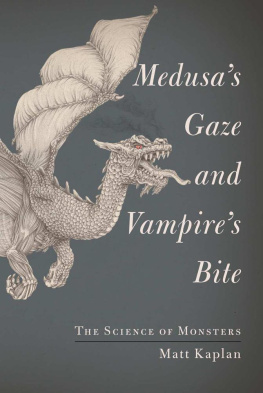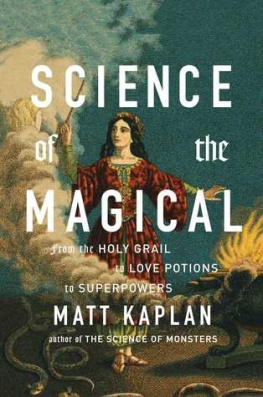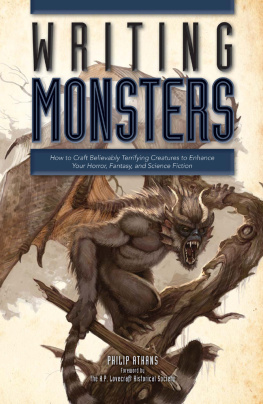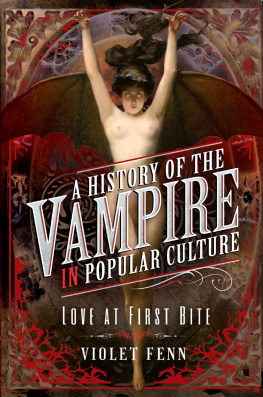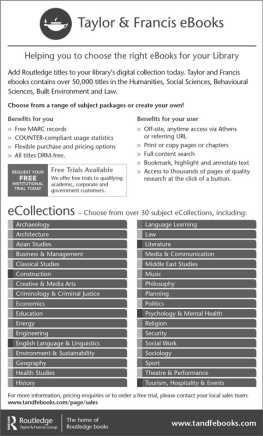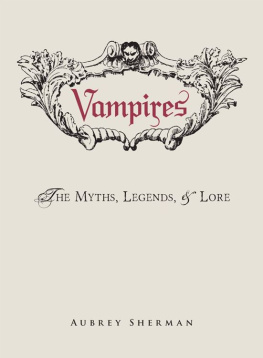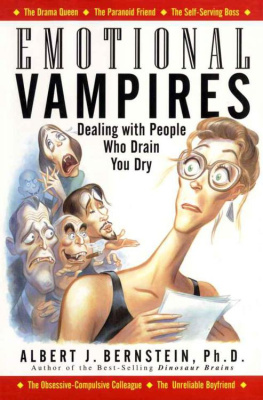
Thank you for purchasing this Scribner eBook.
Join our mailing list and get updates on new releases, deals, bonus content and other great books from Scribner and Simon & Schuster.
C LICK H ERE T O S IGN U P
or visit us online to sign up at
eBookNews.SimonandSchuster.com

Contents
To John Leopold
for bringing monsters into my life
To Thalia and my parents
for putting up with them around the house
Acknowledgments
As a science journalist, your life has a steady rhythm to it. Wednesday and Thursday, read new papers on everything from the chemistry of wine to the behavior of rare parasites. Friday, write up summaries of the most interesting papers that youve found and send these off to editorial. Sunday evening, get your marching orders. Monday, write articles on the papers that editorial liked and communicate with the scientists behind these papers to make sure you arent getting anything wrong. Tuesday, proofread alterations made by editorial and approve publication. Wednesday, do it all over again.
You get exposed to a lot of fascinating and cutting-edge science over the years in this line of work (great for cocktail parties Curtis Marean, Daniel Bartels, David Hankin, David Hughes, Eli Finkel, Elizabeth Lonsdorf, Elizabeth Hadly, Harry Greene, Howard Spero, John Hutchinson, Judith Morales, Lee Kagan, Louis-Philippe Morency, Mrta Korbonits, Michael Benton, Michael Russell, Nathanael Fast, Netsebrak Zewde, Norman Macleod, Paul Eastwick, Paul Rozin, Randy Hill, Ray Kay, Richard Cowen, Robert Ness, and Tony Barnosky, thank you so much for all of your time and effort. To those of you whom I have collaborated with over the years on articles for The Economist, Nature, New Scientist, and National Geographic, it has been a pleasure.
Of course, Medusas Gaze and Vampires Bite explores much more than science. Ancient history and myths are critical to this book and, while I have a soft spot in my heart for these subjects, I studied paleontology at university, not classics. I am thus very grateful to Adrienne Mayor and John Leopold for so meticulously going through the manuscript and offering such valuable advice and support on all things Greek. Epharisto!
Many thanks must also go to Alex Caley, Anna Hankin, Anne Garry, Anthony Hartley, Charlie Hsu, David Attenborough, Evan Mooney, Hsien-I Chien, Judith Seidel, Kate Coe, Matthew Johnson, Nathaniel Bottrell, Rafal Marszalek, Sharon Dewar, and Wilfred Yung for having the courage to tell me when the road through my text got bumpy, and to my agent, Erin Malone, for her helpful feedback throughout this process.
Finally, I owe my editor, Anna DeVries, a great deal of gratitude for convincing me to write this book in the first place.
Or so I hear. None of my friends throw cocktail parties. Maybe Ill throw one when this book gets published just to see if all the stuff in my head is of any use.
Introduction
In the darkness it came. There was no way out. Cornered and helpless, all who found themselves in this dreaded place knew their fate. Relentlessly, the half-human, half-bull fiend found its quarry and tore them to pieces. Scrambling and searching for an exit was pointless. Even if any did miraculously find a way out, the natives of the island were against them. They would simply throw escapees back into the blackness of the depths. Whether their deaths were quick or drawn out remains a mystery, for in the labyrinth of legend on the island of Crete, none of those forced in were ever heard from again.
To those who feel the Minotaur is too ancient to be relevant anymore, consider the fate of the mining vessel Nostromo in Ridley Scotts Alien. Stalked relentlessly by a carnivorous beast, one by one the crew are ripped apart and consumed. It is impossible to find on the shadowy ship, and it makes its attacks almost entirely unseen. Computers, bullets, and flamethrowers are useless. The alien sprays acidic blood when cut that disintegrates armor, burns flesh, and melts bone. There is no escape and no rescue on the way, because in space, no one can hear you scream.
Defined as horrible to behold and a threat to all who cross them, monsters are creatures we run from and beasts we warn our children about. Yet something about them is enticing, mesmerizing, and addictive. Terrible as they might be, we cannot help looking ever closer, parting the fingers that are covering our eyes. There is no getting around it: Something deep inside monsters fascinates us.
What it is about monsters that is so alluring is hard to say. Seeing them makes the heart pump faster, hairs stand on end, and sweat pour down our faces. All of these are signs of stress and are often experienced over and over again through nightmares. Even so, children clamor for ghost stories around the campfire and adults line up in droves to see films featuring vampires and werewolves. They terrify, yet we cannot get enough of them.
And this is nothing new. The Minotaur, Sphinx, and Medusa were created long ago, and based upon their representation in myths, poems, art, and plays, it seems that they drew attention from ancient audiences that was very much like the attention drawn by modern monsters. This hints that monsters have been with us for quite a long time and raises a perplexing question: Why have monster stories, which have the effect of scaring people, persisted so relentlessly throughout the ages?
The masochism tango
As bizarre as it sounds, one answer to this question lies with research on why people like spicy foods. Dishes from Mexico and India are tongue-searingly hot. They make your eyes burn and can soak you with sweat. A lot of people avoid them, but many love them precisely because they are so fiery.
It defies logic that food responsible for such a seemingly painful experience should be so popular, but recent work is beginning to provide an explanation. Fascinated and befuddled by the common human desire to eat mouth-burning foods, psychologist Paul Rozin and a team of colleagues at the University of Pennsylvania wondered whether it was the negative experience of being burned that spicy-food lovers liked or if it was their bodys physiological reactions to these foods that they were enjoying.
The team asked 135 female and 108 male university students to rate on a scale of 0 to 100 how much they liked different things, with 0 indicating not liking at all and 100 indicating considerable liking. When the students were asked, among other things, how much they liked spicy foods, the average score was 55.5, which runs roughly along with the perception that around half of the population enjoys this sort of cuisine. However, far more interesting was that when the participants were asked to rate how much they enjoyed mouth burns, sweating, and tearing eyes, those who rated their love of spicy food at over 50 also tended to rate these typically unpleasant experiences more highly. This suggested they were actually enjoying their bodys own negative response to the food.
The reason for this masochism is not known, but Rozin, along with many others in his field, have a theory that there is pleasure for the mind in watching the body react negatively while knowing perfectly well that nothing bad is actually going to happen. The enjoyment, they suggest, comes from a sense of mental mastery over the body that is responding in a knee-jerk reaction.
Rozins study did not limit itself to an exploration of spicy cuisine. It also asked participants to rate how much they enjoyed thrill rides, frightening movies, gory movies, and even a pounding heart. Again, a connection was found. Those who enjoyed getting the crap scared out of them in movies also tended to like gore, thrill rides, and a pounding heart. Mental mastery might be behind this too.
Next page
